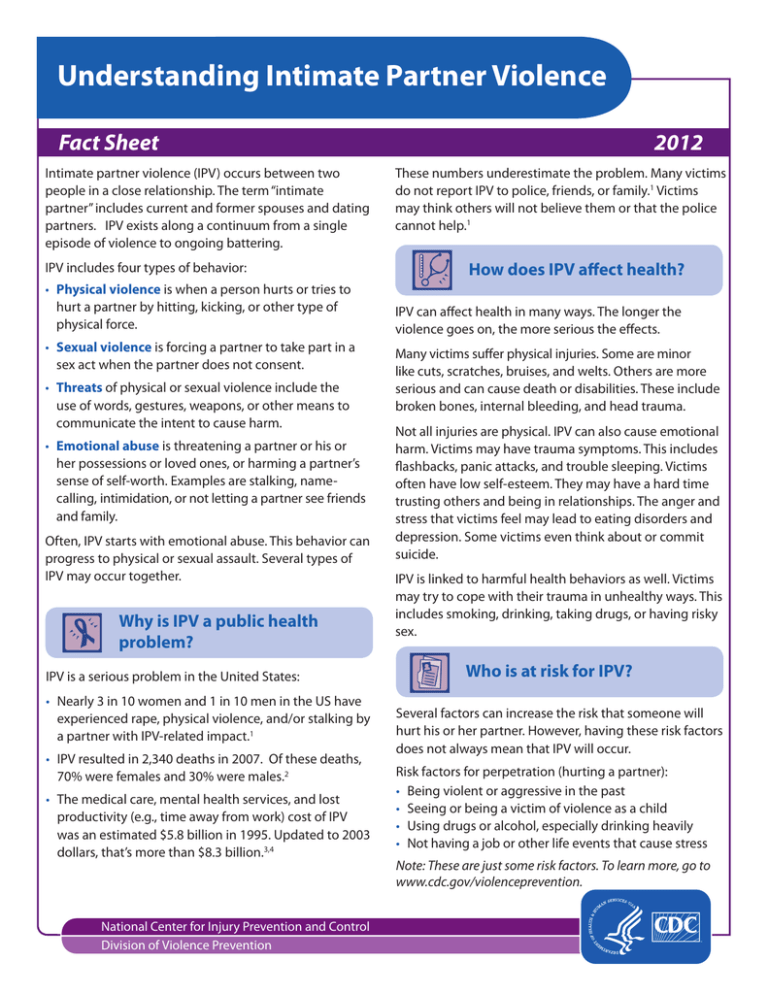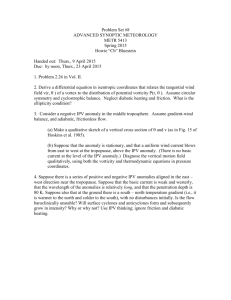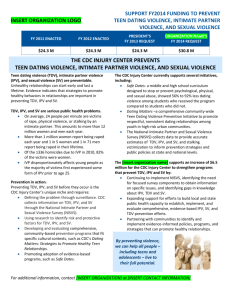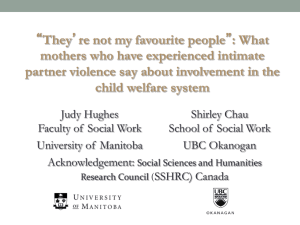
Understanding Intimate Partner Violence
Fact Sheet
Intimate partner violence (IPV) occurs between two
people in a close relationship. The term “intimate
partner” includes current and former spouses and dating
partners. IPV exists along a continuum from a single
episode of violence to ongoing battering.
IPV includes four types of behavior:
• Physical violence is when a person hurts or tries to
hurt a partner by hitting, kicking, or other type of
physical force.
• Sexual violence is forcing a partner to take part in a
sex act when the partner does not consent.
• Threats of physical or sexual violence include the
use of words, gestures, weapons, or other means to
communicate the intent to cause harm.
• Emotional abuse is threatening a partner or his or
her possessions or loved ones, or harming a partner’s
sense of self-worth. Examples are stalking, namecalling, intimidation, or not letting a partner see friends
and family.
Often, IPV starts with emotional abuse. This behavior can
progress to physical or sexual assault. Several types of
IPV may occur together.
Why is IPV a public health
problem?
IPV is a serious problem in the United States:
• Nearly 3 in 10 women and 1 in 10 men in the US have
experienced rape, physical violence, and/or stalking by
a partner with IPV-related impact.1
• IPV resulted in 2,340 deaths in 2007. Of these deaths,
70% were females and 30% were males.2
• The medical care, mental health services, and lost
productivity (e.g., time away from work) cost of IPV
was an estimated $5.8 billion in 1995. Updated to 2003
dollars, that’s more than $8.3 billion.3,4
National Center for Injury Prevention and Control
Division of Violence Prevention
2012
These numbers underestimate the problem. Many victims
do not report IPV to police, friends, or family.1 Victims
may think others will not believe them or that the police
cannot help.1
How does IPV affect health?
IPV can affect health in many ways. The longer the
violence goes on, the more serious the effects.
Many victims suffer physical injuries. Some are minor
like cuts, scratches, bruises, and welts. Others are more
serious and can cause death or disabilities. These include
broken bones, internal bleeding, and head trauma.
Not all injuries are physical. IPV can also cause emotional
harm. Victims may have trauma symptoms. This includes
flashbacks, panic attacks, and trouble sleeping. Victims
often have low self-esteem. They may have a hard time
trusting others and being in relationships. The anger and
stress that victims feel may lead to eating disorders and
depression. Some victims even think about or commit
suicide.
IPV is linked to harmful health behaviors as well. Victims
may try to cope with their trauma in unhealthy ways. This
includes smoking, drinking, taking drugs, or having risky
sex.
Who is at risk for IPV?
Several factors can increase the risk that someone will
hurt his or her partner. However, having these risk factors
does not always mean that IPV will occur.
Risk factors for perpetration (hurting a partner):
• Being violent or aggressive in the past
• Seeing or being a victim of violence as a child
• Using drugs or alcohol, especially drinking heavily
• Not having a job or other life events that cause stress
Note: These are just some risk factors. To learn more, go to
www.cdc.gov/violenceprevention.
Understanding Intimate Partner Violence
How can we prevent IPV?
The goal is to stop IPV before it begins. There is a lot to
learn about how to prevent IPV. We do know that strategies that promote healthy behaviors in relationships are
important. Programs that teach young people skills for
dating can prevent violence. These programs can stop
violence in dating relationships before it occurs.
We know less about how to prevent IPV in adults. However, some programs that teach healthy relationship
skills seem to help stop violence before it ever starts.
How does CDC approach
IPV prevention?
CDC uses a 4-step approach to address public health
problems like IPV.
Where can I learn more?
CDC Facebook Page on Violence Prevention
www.facebook.com/vetoviolence
National Domestic Violence Hotline
1-800-799-SAFE (7233), 1-800-787-3224 TTY, or
www.ndvh.org
National Coalition Against Domestic Violence
www.ncadv.org
National Sexual Violence Resource Center
www.nsvrc.org
Family Violence Prevention Fund
www.endabuse.org
References
Step 1: Define the problem
Before we can prevent IPV, we need to know how big the
problem is, where it is, and whom it affects. CDC learns
about a problem by gathering and studying data. These
data are critical because they help decision makers use
resources where needed most.
1. Black MC, Basile KC, Breiding MJ, Smith SG, Walters
ML, Merrick MT, Chen J, Stevens MR. The National
Intimate Partner and Sexual Violence Survey (NISVS):
2010 Summary Report. Atlanta, GA: National Center
for Injury Prevention and Control, Centers for Disease
Control and Prevention; 2011.
Step 2: Identify risk and protective factors
It is not enough to know that IPV affects certain people
in a certain area. We also need to know why. CDC
conducts and supports research to answer this question.
We can then develop programs to reduce or get rid of
risk factors.
2. Department of Justice, Bureau of Justice Statistics.
Intimate partner violence [online]. [cited 2011 Jan
07]. Available from URL: http://bjs.ojp.usdoj.gov/
index.cfm?ty=tp&tid=971#summary.
Step 3: Develop and test prevention strategies
Using information gathered in research, CDC develops
and evaluates strategies to prevent IPV.
Step 4: Assure widespread adoption
In this final step, CDC shares the best prevention
strategies. CDC may also provide funding or technical
help so communities can adopt these strategies.
For a list of CDC activities, see Preventing Intimate Partner
and Sexual Violence: Program Activities Guide (www.cdc.
gov/violenceprevention/pub/ipv_sv_guide.html).
3. Centers for Disease Control and Prevention (CDC).
Costs of intimate partner violence against women in
the United States. Atlanta (GA): CDC, National Center
for Injury Prevention and Control; 2003. [cited 2006
May 22]. Available from: URL: www.cdc.gov/ncipc/
pub-res/ipv_cost/ipv.htm.
4. Max W, Rice DP, Finkelstein E, Bardwell RA, Leadbetter
S. The economic toll of intimate partner violence
against women in the United States. Violence and
Victims 2004;19(3):259–72.
1-800-CDC-INFO (232-4636) • cdcinfo@cdc.gov • www.cdc.gov/violenceprevention









